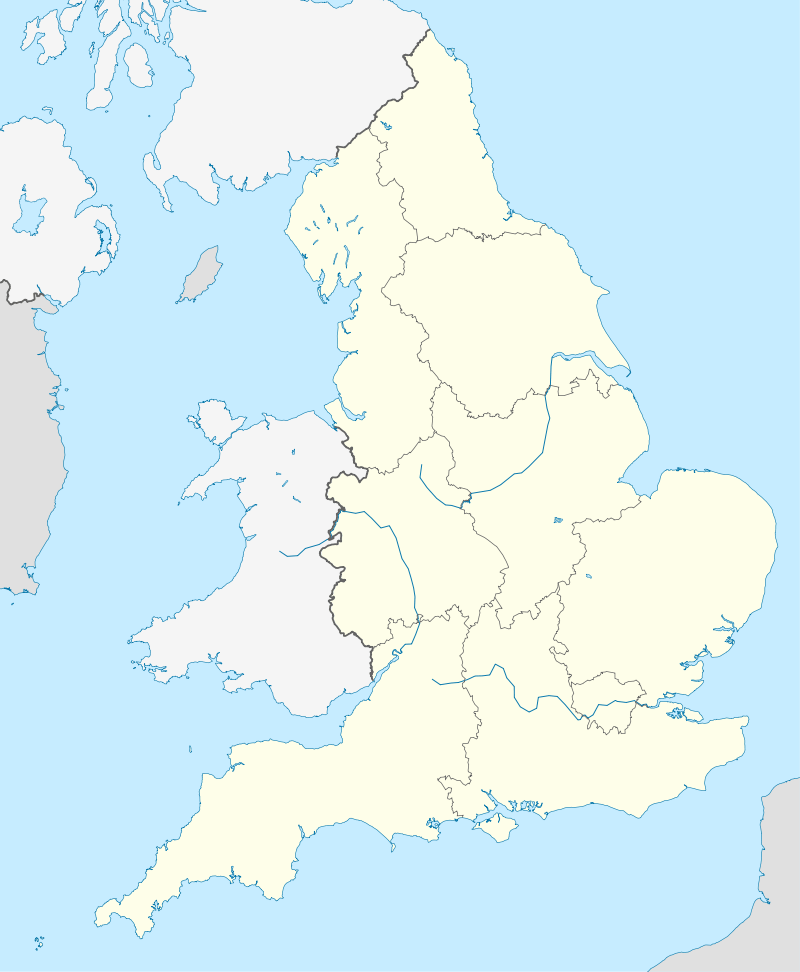Gigg Lane
 Gigg Lane Location of Gigg Lane | |
| Full name | Gigg Lane |
|---|---|
| Location |
Gigg Lane Bury Greater Manchester |
| Owner | Bury F.C. |
| Operator | Bury F.C. |
| Capacity | 11,840 (all-seated) |
| Record attendance | 35,000 |
| Field size | 112 x 73 yards |
| Construction | |
| Built | 1885 |
| Opened | 1885 |
| Tenants | |
|
Bury F.C. (1885–) Swinton RLFC (1992–2002) F.C. United of Manchester (2005–2014) | |
Gigg Lane is an all-seater football stadium in Bury, Greater Manchester, England. It was built for Bury F.C. in 1885, and has been their home ever since.
History
The first match to be played at Gigg Lane was a friendly between Bury and Wigan on 12 September 1885, which Bury won 4–3. The first league game was a 4–2 victory over Manchester City on 8 September 1894 in the 1894–95 Football League Second Division.[1] The stadium has had permanent floodlights since 1953, although the first floodlit match to be played there took place in 1889, before the Football League had authorised the use of floodlights in competitive matches.
The capacity of the ground was once 35,000—and this capacity was reached when the record crowd was achieved for Bury's FA Cup third round tie against Bolton Wanderers on 9 January 1960. The game ended 1–1 and Bury lost the replay after extra time 4–2.[1]
In 1986, Gigg Lane saw its lowest ever crowd of just 461 for a Freight Rover Trophy game against Tranmere Rovers. There has never been a league crowd below 1,000 although the closest to that mark came in 1984 with a crowd of 1,096 against Northampton Town.
The highest all-seater attendance at Gigg Lane was recorded when Bury played local rivals Manchester City 12th Sept 1997, with an attendance of 11,216.
The ground was renamed the JD Stadium in November 2013 after Bury announced a new sponsorship deal with JD Sports.[2] The deal was ended in July 2015.
Structure and facilities
The stadium's current capacity is 11,840. The South Stand is the largest stand and it was renamed the "Les Hart Stand" in the summer of 2010.[3] The stand contains a pattern of blue and white seats that spell out "SHAKERS"
After the Taylor Report forced all Football League clubs to switch to all-seater stadiums, the stadium began converting all four sides of the ground in 1993, with the Cemetery End being the final terraced section to be demolished in 1999.
The Manchester Road End (capacity 2,100) was home to the club's electronic scoreboard (obtained from Leicester City's Filbert Street ground after it closed in 2002) until 2011. A new scoreboard was placed in the south-east corner of the ground a few months later.[4]
The Cemetery End (the east stand) has capacity of 2,500.
In September 2015 a screen was installed in the right-hand side of the Les Hart Stand. On Match-Days the club show advertisements, match highlights and the scoreline.
Towards the end of the 2015–16 season, a fence was constructed between the Cemetery End and the Les Hart Stand in an attempt to stop the club's rise of hooliganism. This further separates both Home and Away supporters.
Other users
Manchester United and Bolton Wanderers have hosted reserve-team matches at the ground.
F.C. United of Manchester shared the ground from the 2005–06 season until 2014. They moved into their own ground for the 2015–16 season. F.C. United set a club record attendance of 6,731 when they played Brighton and Hove Albion in the FA Cup on 8 December 2010.
A couple of teams have "switched" their home games to the stadium, including Preston North End for a League Cup tie in 1994. Non-league sides Rossendale United and Radcliffe Borough moved home F.A. Cup ties to Gigg Lane against Bolton Wanderers (in 1971) and York City respectively.[1]
In 1996, the stadium was used as the filming location for the TV film based on the Hillsborough disaster of 1989, where 96 Liverpool fans died as a result of a crush on the stadium's terraces. Hillsborough was seen as an unsuitable location for the film, partly to avoid causing further distress to survivors and bereaved families, and partly because the appearance of Gigg Lane was more akin to the 1989 Hillsborough than the actual stadium was seven years after the tragedy due to redevelopment.[5]
The stadium has been used for many sports other than football, such as rugby league (Swinton Lions played at Gigg Lane between 1992 and 2002), cricket, baseball and lacrosse.
References
- 1 2 3 Gordon Sorfleet (18 June 2012). "Gigg Lane, the home of Bury Football Club". Bury FC. Retrieved 4 November 2012.
- ↑ Paul Handler. "Gigg Lane renamed JD Stadium after Bury FC strike commercial deal". Manchester Evening News. Retrieved 2013-11-12.
- ↑ The Les Hart Stand buryfc.co.uk
- ↑ "New Scoreboard installed". Buryfc.co.uk. 2011-05-17. Retrieved 2013-11-12.
- ↑ Hillsborough at the Internet Movie Database
External links
Coordinates: 53°34′49.82″N 2°17′41.36″W / 53.5805056°N 2.2948222°W